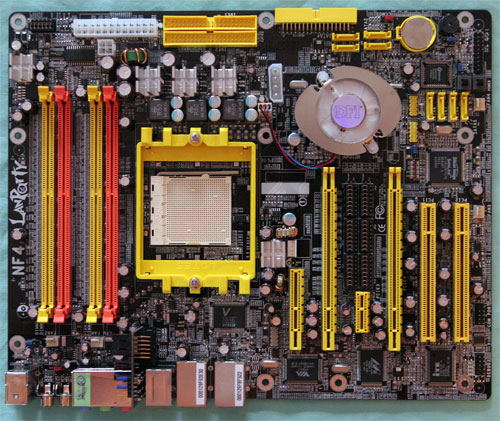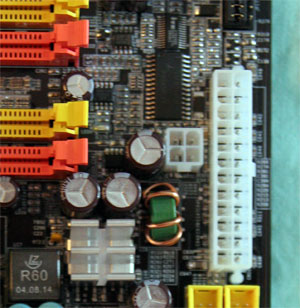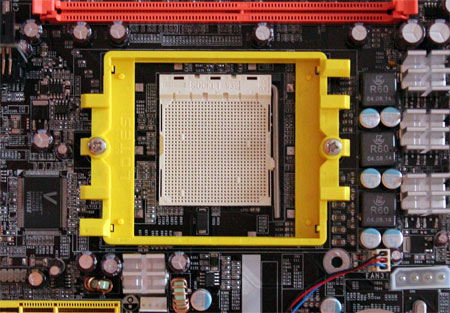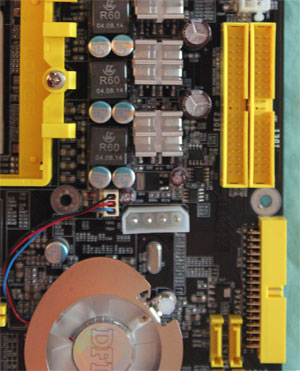DFI nForce4: SLI and Ultra for Mad Overclockers
by Wesley Fink on February 5, 2005 9:30 AM EST- Posted in
- Motherboards
Board Layout: DFI nForce4
Each new generation of DFI motherboards seem to be improving on board design, and the DFI nForce4 boards feature a very functional layout.

The DFI nF4 places the CPU in the top center of the board and DIMMs at the top. This arrangement worked well in our testing and should work better for those who change memory frequently than the crowded right edge location used on most boards.

The ATX 24-pin and the 4-pin 12V connector are in ideal locations on the DFI nF4. The bulky 24-pin ATX is located on the preferred top right edge of the motherboard, and the 4-pin 12V power connector is right beside it. This board-edge location keeps bulky cables away from the CPU and memory.

The CPU socket is in the top center of the board. PCI slots are below the socket and memory is above the CPU. There is plenty of room around the Socket 939, so most Heatsink/Fans should work fine. A Zalman 7000 overhung DIMM slot 4, but it still cleared our stock OCZ memory and dimms could work in all slots.

The IDE connectors are at our preferred upper right edge of the motherboard, and the floppy connector is a board edge connector about right midline of the board. Both locations are nearly ideal and worked well in our testing. If you use a floppy drive, you might want to connect the floppy before screwing down the board, as many mid-tower cases are tight in the area of the floppy connector. Having said that, we would still choose this floppy location any day over the floppy placed at the bottom of the board.

SATA connectors are to the right of the nF4 chipset and the magnetic levitation fan. The fan is low enough for video cards - both ATI and nVidia - to mount properly. We tried both ATI and nVidia top-of-the line cards to make sure.

Most competitive boards with 2 x16 PCIe video slots use a simple card edge selector that is reversed for SLI operation. DFI uses 6 jumper blocks that must all be moved to switch to SLI mode.
DFI also continues CMOS reloaded, which was introduced with the second generation LANParty boards. This feature allows you to save several different custom BIOS set-ups so that you can recall custom BIOS settings easily for a particular overclock or settings for a different OS. Overclockers and users who run multiple operating systems will really find CMOS Reloaded to be a useful feature.










114 Comments
View All Comments
Avalon - Saturday, February 5, 2005 - link
If you don't like the exclusive, wait for the NF4 roundup. It's that simple. Just because you feel enough data wasn't included in an ARTICLE, doesn't mean that Anandtech does not have such data in their LABS waiting to be released. Again, wait for the roundup.overclockingoodness - Saturday, February 5, 2005 - link
Justimann: Like others pointed out, Wesley is one of the most respected journalists in this industry. And AnandTech is one of the best sites as well, so I doubt they will be putting their integrity on line just to get a damn exclusive. AnandTech is just like any business but I am proud to say that I have hardly seen any bias on this site (the only bias may be disagreement between my interpretion of the reviwer's words).AnandTech would never recommend anything unless they are confident about it and even if the data is not on the graph, we trust AnandTech's editors.
DEMO24 - Saturday, February 5, 2005 - link
I dont remeber if people have asked this yet(having a feeling they have, but I dont want to read 5 pages of replys;)) but do you guys at Anandtech still have some Winchestor CPUs lieing around? Would be nice to see how far you could get one :)bersl2 - Saturday, February 5, 2005 - link
#79, #80: It's got nothing to do with any of that. SLI nForce4 chips have a price premium on them. Every Ultra sold instead of an SLI means less money for nVidia.joe4324 - Saturday, February 5, 2005 - link
Its more likely that nvidia doesnt want to deal with supporting hardware running out of spec AND beyond its intentions, There not stupid, they know how people are. Even if this board preformed perfectly in all ways, UNTILL you modded it. then it caught fire. They would be slamed for being unreliable and unsafe, and thus not worth buying. even though it was the best mobo out at the time, when NOT modded.rjm55 - Saturday, February 5, 2005 - link
I don't get it. Why did nVidia do this? If anybody did a mod to SLI they had to buy two nVidia video cards to use SLI. So nVidia got more profit. Looks like they couldn't lose with SLI only working with nV cards.Guess nVidia has now totally forgotten their gaming and enthusiast roots and they're just another big company throwing around their weight. Maybe ATI will do better.
Wesley Fink - Saturday, February 5, 2005 - link
The following Update has just been added to the front page of the review:"UPDATE 2/05/2005: nVidia has acted to prevent, or at least make it more difficult, to mod the Ultra board to SLI. First, DFI has advised us, and posted on their website, that they will NOT sell the SLI bridge to buyers of the Ultra board. Second, nVidia has advised us that future shipments of the Ultra chipset have been modified so that the mod to SLI will no longer be possible. An additional side effect of this second action is that the "Dual Video" mode, which performs at about 90% of SLI performance levels, will only work with early nVidia drivers 66.75 or earlier. If you do a quick check of web driver postings you will see it is now very difficult to find 66.75 drivers. With a chipset modded to SLI the "Dual Video" mode worked through 70.xx versions of the nVidia driver. nVidia also made it clear they will continue to make driver changes to prevent operation of any "non-standard" (8X/8X) operation of their SLI driver. This also throws into question whether the VIA "dual graphics" mode on the 894 Pro chipset will ever work with nVidia graphics cards. If you are interested in the current UT Ultra-D we suggest you buy one now if you can find it. Future versions of the UT Ultra-D will not have the same capabilities as a result of these actions."
ImJacksAmygdala - Friday, February 4, 2005 - link
I guess beauty is hard to quantify. Like Wesley said he has saved the Editor's Choice Award for the SLI board review that will provide more hard data to support his opinion on the DFI board.justinmann - Friday, February 4, 2005 - link
Dear Gerbil, I am not wasting my time. I read the article, and like any good scientist I looked at the data. The data do not support the conclusions, therefore I felt it necessary to ask why he did not perform an experiment that backed up his proclamation. It's really a pretty simple concept.Justin
Happy Buddha - Friday, February 4, 2005 - link
Hey Wesley,You did use a IDE HDD for benchmarking so the question about SATA and overclocking pop right to my mind: Is Overclocking as stable with SATA drives?!?
I know that the NF3 250GB was, but sometime engineer can make silly mistake. ;)
An can you or DFI confirm that the low end (Utra-D) will have as much success with OC? Thanks...